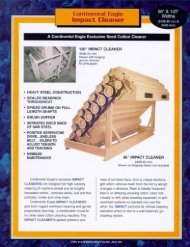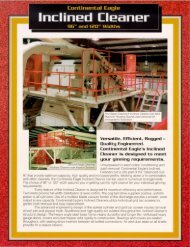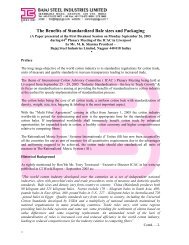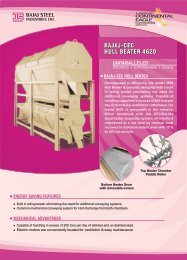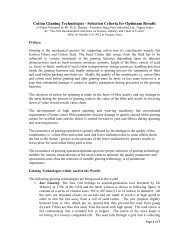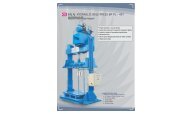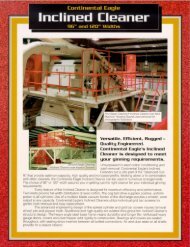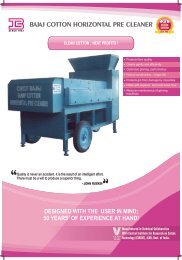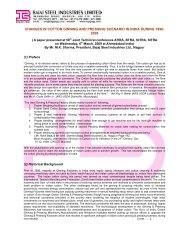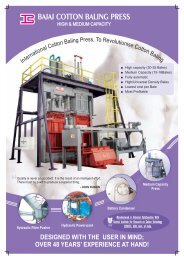recent advances in ginning for lowering cost and ... - Bajaj Group
recent advances in ginning for lowering cost and ... - Bajaj Group
recent advances in ginning for lowering cost and ... - Bajaj Group
Create successful ePaper yourself
Turn your PDF publications into a flip-book with our unique Google optimized e-Paper software.
(RECENT ADVANCES IN GINNING FOR LOWERING COST AND IMPROVING OF EFFICIENCY)<br />
# 3 #<br />
The average saw g<strong>in</strong> turns out about 500 kg of l<strong>in</strong>t per hour. However, saw g<strong>in</strong> gives about 1% to 3.5% less<br />
g<strong>in</strong>n<strong>in</strong>g percentage than s<strong>in</strong>gle <strong>and</strong> double roller g<strong>in</strong>. Although the g<strong>in</strong>n<strong>in</strong>g output of saw g<strong>in</strong> is very high,<br />
these g<strong>in</strong>s are not suitable <strong>for</strong> g<strong>in</strong>n<strong>in</strong>g extra-long staple (ELS) varieties <strong>and</strong> the l<strong>in</strong>t is more nappy than the<br />
roller g<strong>in</strong>ned l<strong>in</strong>t. The ma<strong>in</strong>tenance of saw g<strong>in</strong> is very <strong>cost</strong>ly because there are many mov<strong>in</strong>g parts which are<br />
of special construction <strong>and</strong> many times are not readily available. Further, a qualified <strong>and</strong> experienced<br />
technician is required to operate saw g<strong>in</strong> st<strong>and</strong> to get the optimum output <strong>and</strong> to replace the worn out parts<br />
<strong>and</strong> adjust the g<strong>in</strong> <strong>for</strong> uni<strong>for</strong>m process<strong>in</strong>g of seed cotton. In view of limitations <strong>in</strong> respect of g<strong>in</strong>n<strong>in</strong>g short <strong>and</strong><br />
medium staple cotton only, fibre length cutt<strong>in</strong>g <strong>and</strong> higher neps, saw g<strong>in</strong> <strong>in</strong> the countries like India where<br />
different varieties of different fibre parameters are grown has been phased out completely by double roller<br />
g<strong>in</strong>s.<br />
The roller g<strong>in</strong>s are classified as oscillatory knife g<strong>in</strong> <strong>and</strong> rotary knife g<strong>in</strong> depend<strong>in</strong>g upon the type of motion of<br />
mov<strong>in</strong>g knife. Oscillatory type g<strong>in</strong>s are further classified as s<strong>in</strong>gle roller (SR) <strong>and</strong> Double roller (DR) depend<strong>in</strong>g<br />
on the number of rollers used per mach<strong>in</strong>e while Rotary Knife g<strong>in</strong> is called Rotobar.<br />
3.3.1 S<strong>in</strong>gle roller g<strong>in</strong> - McCarthy g<strong>in</strong><br />
The pr<strong>in</strong>ciple of work<strong>in</strong>g of s<strong>in</strong>gle roller g<strong>in</strong> is popularly known as McCarthy pr<strong>in</strong>ciple named after its<br />
proponent <strong>and</strong> shown <strong>in</strong> Figure3.3.<br />
Figure 3.3.1 S<strong>in</strong>gle Roller G<strong>in</strong><br />
It lies <strong>in</strong> pick<strong>in</strong>g <strong>and</strong> then mov<strong>in</strong>g the cotton fibres between the roller <strong>and</strong> fixed knife prevent<strong>in</strong>g the seeds to<br />
pass through. The seed cotton, when thrown <strong>in</strong>to the hopper, passes through the mach<strong>in</strong>e. While the<br />
mach<strong>in</strong>e is work<strong>in</strong>g, at each elevation of the mov<strong>in</strong>g knife the grids lift the cotton to the level of the stationary<br />
knife-edge <strong>and</strong> of the exposed surface of the rollers. The free ends of the fibres are gripped, <strong>in</strong> the grooves of<br />
the rotat<strong>in</strong>g roller, <strong>and</strong> dragged <strong>for</strong>ward till the seeds reach the edge of stationary knife. The edge where the<br />
fibre is caught is the g<strong>in</strong>n<strong>in</strong>g po<strong>in</strong>t. By the downward motion of the mov<strong>in</strong>g knife, the seeds are detached from<br />
the cotton at the g<strong>in</strong>n<strong>in</strong>g po<strong>in</strong>t <strong>and</strong> are thrown out through the slots of the grid. It is important that the grooves<br />
of the rollers should be kept well open <strong>and</strong> when the leather roller becomes smooth, rough file should be<br />
applied occasionally to the surface to keep the same grip <strong>and</strong> pull on the fibre. The seeds are then hammered<br />
by means of the rapidly mov<strong>in</strong>g knife whereby some fibres are separated. In subsequent cycles, the rema<strong>in</strong><strong>in</strong>g<br />
fibres also get separated. This process is cont<strong>in</strong>ued till all the fibres from the seed get removed. The s<strong>in</strong>gle<br />
roller g<strong>in</strong>s have been phased out <strong>in</strong> India by Double Roller G<strong>in</strong>s due to lower production <strong>in</strong> s<strong>in</strong>gle roller g<strong>in</strong>s at<br />
same electrical power <strong>and</strong> manpower <strong>cost</strong>.<br />
Contd. …4.



